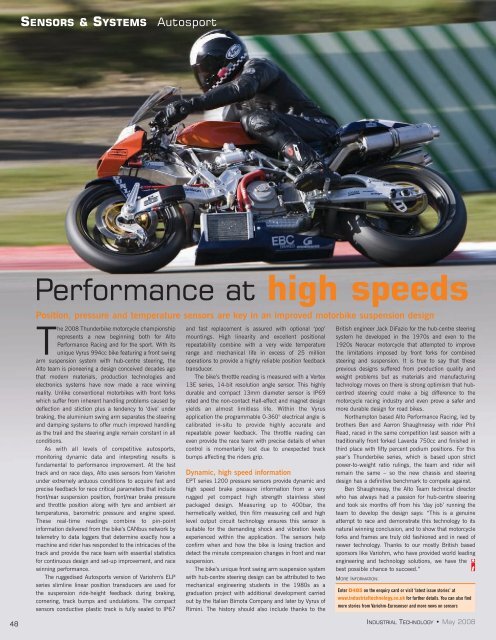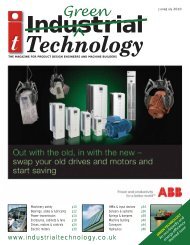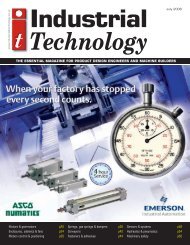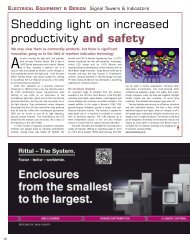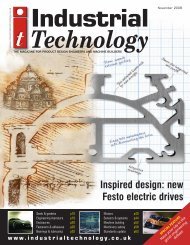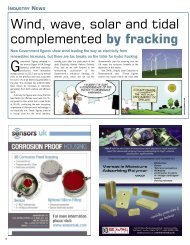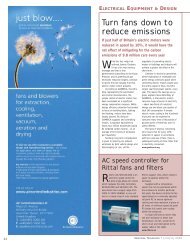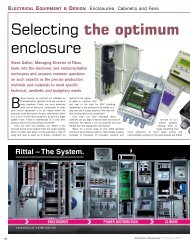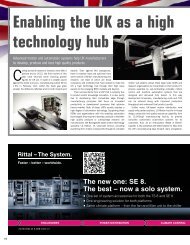sensors & systems - Industrial Technology Magazine
sensors & systems - Industrial Technology Magazine
sensors & systems - Industrial Technology Magazine
Create successful ePaper yourself
Turn your PDF publications into a flip-book with our unique Google optimized e-Paper software.
SENSORS & SYSTEMS<br />
Autosport<br />
Performance at high speeds<br />
Position, pressure and temperature <strong>sensors</strong> are key in an improved motorbike suspension design<br />
The 2008 Thunderbike motorcycle championship<br />
represents a new beginning both for Alto<br />
Performance Racing and for the sport. With its<br />
unique Vyrus 994cc bike featuring a front swing<br />
arm suspension system with hub-centre steering, the<br />
Alto team is pioneering a design conceived decades ago<br />
that modern materials, production technologies and<br />
electronics <strong>systems</strong> have now made a race winning<br />
reality. Unlike conventional motorbikes with front forks<br />
which suffer from inherent handling problems caused by<br />
deflection and stiction plus a tendency to ‘dive’ under<br />
braking, the aluminium swing arm separates the steering<br />
and damping <strong>systems</strong> to offer much improved handling<br />
as the trail and the steering angle remain constant in all<br />
conditions.<br />
As with all levels of competitive autosports,<br />
monitoring dynamic data and interpreting results is<br />
fundamental to performance improvement. At the test<br />
track and on race days, Alto uses <strong>sensors</strong> from Variohm<br />
under extremely arduous conditions to acquire fast and<br />
precise feedback for race critical parameters that include<br />
front/rear suspension position, front/rear brake pressure<br />
and throttle position along with tyre and ambient air<br />
temperatures, barometric pressure and engine speed.<br />
These real-time readings combine to pin-point<br />
information delivered from the bike’s CANbus network by<br />
telemetry to data loggers that determine exactly how a<br />
machine and rider has responded to the intricacies of the<br />
track and provide the race team with essential statistics<br />
for continuous design and set-up improvement, and race<br />
winning performance.<br />
The ruggedised Autosports version of Variohm's ELP<br />
series slimline linear position transducers are used for<br />
the suspension ride-height feedback during braking,<br />
cornering, track bumps and undulations. The compact<br />
<strong>sensors</strong> conductive plastic track is fully sealed to IP67<br />
and fast replacement is assured with optional ‘pop’<br />
mountings. High linearity and excellent positional<br />
repeatability combine with a very wide temperature<br />
range and mechanical life in excess of 25 million<br />
operations to provide a highly reliable position feedback<br />
transducer.<br />
The bike’s throttle reading is measured with a Vertex<br />
13E series, 14-bit resolution angle sensor. This highly<br />
durable and compact 13mm diameter sensor is IP69<br />
rated and the non-contact Hall-effect and magnet design<br />
yields an almost limitless life. Within the Vyrus<br />
application the programmable 0-360° electrical angle is<br />
calibrated in-situ to provide highly accurate and<br />
repeatable power feedback. The throttle reading can<br />
even provide the race team with precise details of when<br />
control is momentarily lost due to unexpected track<br />
bumps affecting the riders grip.<br />
Dynamic, high speed information<br />
EPT series 1200 pressure <strong>sensors</strong> provide dynamic and<br />
high speed brake pressure information from a very<br />
rugged yet compact high strength stainless steel<br />
packaged design. Measuring up to 400bar, the<br />
hermetically welded, thin film measuring cell and high<br />
level output circuit technology ensures this sensor is<br />
suitable for the demanding shock and vibration levels<br />
experienced within the application. The <strong>sensors</strong> help<br />
confirm when and how the bike is losing traction and<br />
detect the minute compression changes in front and rear<br />
suspension.<br />
The bike’s unique front swing arm suspension system<br />
with hub-centre steering design can be attributed to two<br />
mechanical engineering students in the 1980s as a<br />
graduation project with additional development carried<br />
out by the Italian Bimota Company and later by Vyrus of<br />
Rimini. The history should also include thanks to the<br />
British engineer Jack DiFazio for the hub-centre steering<br />
system he developed in the 1970s and even to the<br />
1920s Neracar motorcycle that attempted to improve<br />
the limitations imposed by front forks for combined<br />
steering and suspension. It is true to say that these<br />
previous designs suffered from production quality and<br />
weight problems but as materials and manufacturing<br />
technology moves on there is strong optimism that hubcentred<br />
steering could make a big difference to the<br />
motorcycle racing industry and even prove a safer and<br />
more durable design for road bikes.<br />
Northampton based Alto Performance Racing, led by<br />
brothers Ben and Aarron Shaughnessy with rider Phil<br />
Read, raced in the same competition last season with a<br />
traditionally front forked Laverda 750cc and finished in<br />
third place with fifty percent podium positions. For this<br />
year’s Thunderbike series, which is based upon strict<br />
power-to-weight ratio rulings, the team and rider will<br />
remain the same – so the new chassis and steering<br />
design has a definitive benchmark to compete against.<br />
Ben Shaughnessy, the Alto Team technical director<br />
who has always had a passion for hub-centre steering<br />
and took six months off from his ‘day job’ running the<br />
team to develop the design says: “This is a genuine<br />
attempt to race and demonstrate this technology to its<br />
natural winning conclusion, and to show that motorcycle<br />
forks and frames are truly old fashioned and in need of<br />
newer technology. Thanks to our mostly British based<br />
sponsors like Variohm, who have provided world leading<br />
engineering and technology solutions, we have the<br />
best possible chance to succeed.”<br />
MORE INFORMATION:<br />
Enter D485 on the enquiry card or visit ‘latest issue stories’ at<br />
www.industrialtechnology.co.uk for further details. You can also find<br />
more stories from Variohm-Eurosensor and more news on <strong>sensors</strong><br />
48<br />
INDUSTRIAL TECHNOLOGY • May 2008


